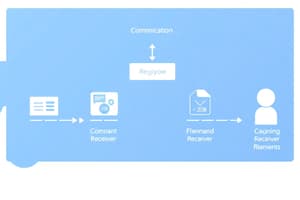Podcast
Questions and Answers
Which of the following is a form of intrapersonal communication?
Which of the following is a form of intrapersonal communication?
- Vocal Discourse
- Written Discourse
- Internal Discourse
- All of the above (correct)
Interpersonal communication occurs only in direct face-to-face situations.
Interpersonal communication occurs only in direct face-to-face situations.
False (B)
What is the key aspect of public presentational context?
What is the key aspect of public presentational context?
A single speaker creating meaning with an audience.
In mass communication, the sender of the message cannot see or observe how the audience reacts, which is often conducted through __________.
In mass communication, the sender of the message cannot see or observe how the audience reacts, which is often conducted through __________.
Match the following communication contexts with their descriptions:
Match the following communication contexts with their descriptions:
Which element of communication is responsible for sending the message?
Which element of communication is responsible for sending the message?
Noise can only be external and does not include internal factors.
Noise can only be external and does not include internal factors.
What is the term used for the recipient of a message in communication?
What is the term used for the recipient of a message in communication?
The __________ provides insight into how the receiver interprets the message.
The __________ provides insight into how the receiver interprets the message.
Match the following communication elements with their definitions:
Match the following communication elements with their definitions:
Which of the following is NOT considered a medium of communication?
Which of the following is NOT considered a medium of communication?
The frame of reference includes only the sender's experiences.
The frame of reference includes only the sender's experiences.
What is the effect of noise on communication?
What is the effect of noise on communication?
What reinforcement did the KLM captain misinterpret from the controller's response?
What reinforcement did the KLM captain misinterpret from the controller's response?
Intrapersonal communication is primarily about communication between individuals.
Intrapersonal communication is primarily about communication between individuals.
Name the three general types of context in communication.
Name the three general types of context in communication.
The self-concept refers to how someone thinks about, evaluates, or perceives their __________.
The self-concept refers to how someone thinks about, evaluates, or perceives their __________.
Match the aspects of intrapersonal communication with their descriptions:
Match the aspects of intrapersonal communication with their descriptions:
Which type of context includes the emotional history and social relationships of individuals?
Which type of context includes the emotional history and social relationships of individuals?
Expectations in intrapersonal communication are about immediate actions rather than long-term roles.
Expectations in intrapersonal communication are about immediate actions rather than long-term roles.
What is intrapersonal communication commonly known as?
What is intrapersonal communication commonly known as?
Which type of noise includes distractions caused by physical surroundings?
Which type of noise includes distractions caused by physical surroundings?
Psychological noise can include emotional barriers, such as anxiety and emotional mistrust.
Psychological noise can include emotional barriers, such as anxiety and emotional mistrust.
What is referred to as the sociological barrier in communication?
What is referred to as the sociological barrier in communication?
_____ noise is characterized by the physiological state of an individual affecting communication.
_____ noise is characterized by the physiological state of an individual affecting communication.
Which barrier arises due to differing practices and beliefs among various cultural groups?
Which barrier arises due to differing practices and beliefs among various cultural groups?
A perceptual barrier occurs when an individual believes their message will not be understood by others.
A perceptual barrier occurs when an individual believes their message will not be understood by others.
What does the term 'gender barrier' refer to in communication?
What does the term 'gender barrier' refer to in communication?
Match the following types of noise with their descriptions:
Match the following types of noise with their descriptions:
Flashcards
Intrapersonal Communication
Intrapersonal Communication
Communication that takes place within oneself, involving thoughts, feelings, and internal dialogue.
Interpersonal Communication (Direct)
Interpersonal Communication (Direct)
Communication that occurs between two or more people, involving face-to-face interaction.
Interpersonal Communication (Indirect)
Interpersonal Communication (Indirect)
Communication that occurs between two or more people, involving technology as a medium.
Group Context
Group Context
Signup and view all the flashcards
Organizational Context
Organizational Context
Signup and view all the flashcards
Sender
Sender
Signup and view all the flashcards
Medium
Medium
Signup and view all the flashcards
Channel
Channel
Signup and view all the flashcards
Receiver
Receiver
Signup and view all the flashcards
Feedback
Feedback
Signup and view all the flashcards
Noise
Noise
Signup and view all the flashcards
Context
Context
Signup and view all the flashcards
Frame of Reference
Frame of Reference
Signup and view all the flashcards
Psychosocial Context
Psychosocial Context
Signup and view all the flashcards
Logistical Context
Logistical Context
Signup and view all the flashcards
Interactional Context
Interactional Context
Signup and view all the flashcards
Perceptions (Intrapersonal Communication)
Perceptions (Intrapersonal Communication)
Signup and view all the flashcards
Self-Concept (Intrapersonal Communication)
Self-Concept (Intrapersonal Communication)
Signup and view all the flashcards
Expectations (Intrapersonal Communication)
Expectations (Intrapersonal Communication)
Signup and view all the flashcards
Communication Barrier
Communication Barrier
Signup and view all the flashcards
External Noise
External Noise
Signup and view all the flashcards
Internal Noise
Internal Noise
Signup and view all the flashcards
Physiological Noise
Physiological Noise
Signup and view all the flashcards
Psychological Noise
Psychological Noise
Signup and view all the flashcards
Emotional Barrier
Emotional Barrier
Signup and view all the flashcards
Perceptual Barrier
Perceptual Barrier
Signup and view all the flashcards
Culture Barrier
Culture Barrier
Signup and view all the flashcards
Study Notes
Elements of Communication
- Communication involves a sender, channel, receiver, and feedback
- The sender initiates the communication process by creating a message and selecting a channel
- The sender encodes the message to make it clear
- The receiver decodes the message and responds or gives feedback
- The medium is the channel used to deliver the message (e.g., print, mass media, electricity, digital)
- The channel is the method of delivering the message to the target audience (e.g., phone calls, text messages)
- Feedback is the response or reaction from the receiver of the message
- Noise is anything that obstructs the communication process, including internal and external elements
Context of Communication
- Context consists of observable conditions that help sender and receiver understand a message together
- Communication is affected by physical, psychological, social, and cultural contexts
- Physical context includes factors of time, place, and occasion
- Psychological context relates to the emotional history, social relationships, and cultural capital of those participating in the communication
- Interactional context encompasses interpersonal, group, organizational, public presentational, and mass communication
Noise and Communication Barriers
- Noise interrupts the process of communication
- External noise factors include objects, equipment, or materials (e.g., wall dividers, doors)
- Internal noise factors include psychological barriers (emotional, perceptual, cultural, gender, sociological), and semantic barriers
Intrapersonal Communication
- Intrapersonal communication is communication with oneself, involving self-talk, thoughts, feelings, and ideas
- It is essential for understanding oneself and connecting with one's inner voice
- Perceptions, self-concept, and expectations are three aspects of intrapersonal communication
- Internal, vocal, and written discourse are forms of intrapersonal communication
Interpersonal Communication
- Interpersonal communication can be direct or indirect
- Direct communication occurs in face-to-face interactions
- Indirect communication involves technology (e.g., virtual communication)
- Tone of voice, body language, and expressions are considerations for effective interpersonal communication
Types of Communication Contexts
- Group context involves more than two people
- Organizational context includes workplace communication, exposing individuals to numerous communication opportunities
- Public presentational context involves a single speaker addressing an audience (formal/informal)
- Mass communication context involves individuals/networks sharing messages with a broad audience
Studying That Suits You
Use AI to generate personalized quizzes and flashcards to suit your learning preferences.




